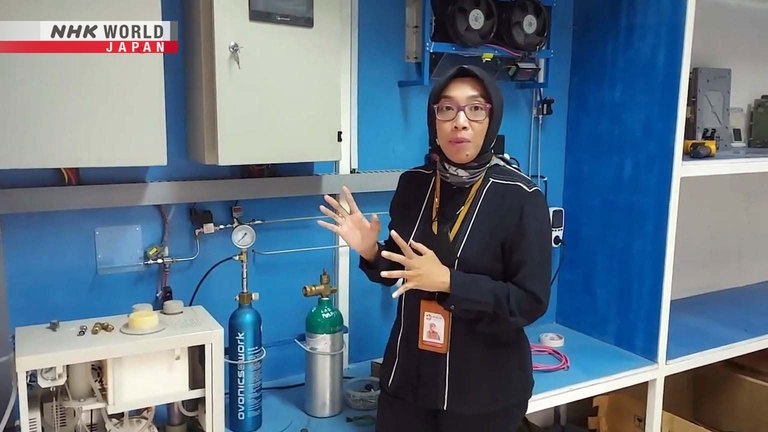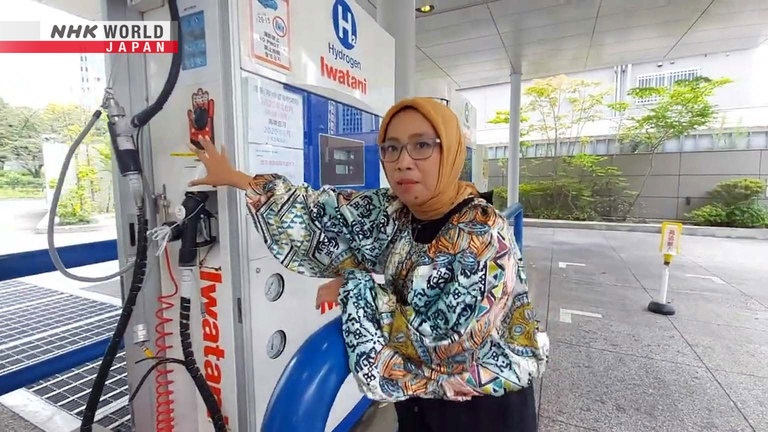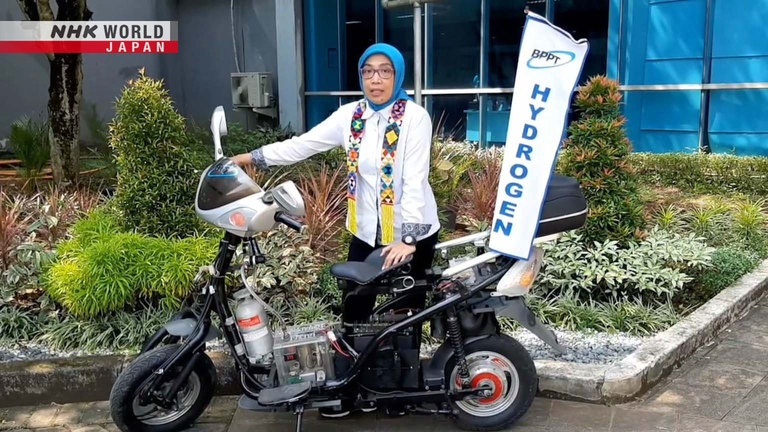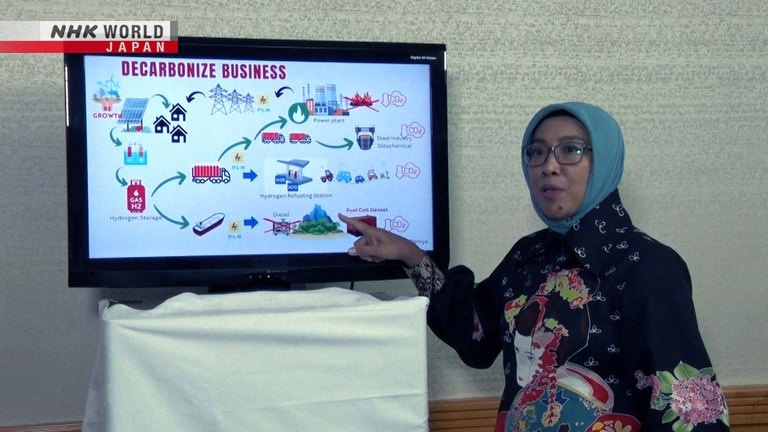Hydrogen to Change Society: Eniya Listiani Dewi / Fuel Cell Research Professor
We feature a scientist, Eniya Listiani Dewi, who is leading energy reform in Indonesia by aiming to create a sustainable society using "green" hydrogen produced from only natural energy.




Transcript
Direct Talk
Air pollution in Jakarta,
the capital of Indonesia,
is worsening year by year.
One major contributor is the large number
of automobiles and motorbikes.
Indonesia has lagged behind much of the world
in tackling environmental issues,
but is now transforming itself
into an energy-developed nation.
Dr. Eniya Listiani Dewi
is leading the charge.
Eniya Listiani Dewi
Fuel Cell Research Professor
I'm doing my research in the topic
of fuel cells development
and also the hydrogen production.
I think when once we use a hydrogen,
there is no carbon anymore.
This scientist endeavors to harness hydrogen
in her campaign to create
the world's most advanced city.
Hydrogen to Change Society
The transportation in Indonesia
is a big problem.
I look at the Jakarta city as my home office,
is so polluted city.
So I want to try to reduce the pollutant
especially in my countries.
Then I start to make a fuel cells.
A fuel cell generates electricity
through a chemical reaction
between hydrogen and oxygen.
Fuel cell vehicles
use this electricity for power.
The only emission is water;
thus, fuel cells are being developed
around the world to provide clean energy.
Eniya's first foray into hydrogen tech was
to develop a motorbike that runs on hydrogen.
But why choose motorbikes?
About half the population of Indonesia
uses them to get around;
that amounts to 125 million
motorbikes on the road.
Eniya aims to promote the use of
clean fuel cells to everyone.
Many people use their own transportation,
so they have an interest with
the new model of transportation,
so especially I want to
make people know about the hydrogen.
And then we can share
about the knowledge of hydrogen
as a new generation,
as a zero-emission product.
Then we can make people getting
more aware to the environment.
To achieve the goal of zero emissions,
Eniya believes that people need to change
how they think about energy.
The pollution is, in Jakarta is
in many reason
we have a power plant, of course,
and then we have also the transportation.
And I think
not only the power generation,
not only the transportation sector,
there is an industrial sector also
that many, many energy
are using a coal as a power.
But we have many potential to produce
the hydrogen from our resources.
Because we have many water,
we have many electricity from renewable,
we have many geothermal, so we can produce
the hydrogen in the clean way.
Hydrogen is colorless and transparent,
but is assigned a symbolic color
depending on how it was produced.
Green hydrogen is made
using renewable energy,
without carbon dioxide emissions,
making it an eco-friendly energy source.
Indonesia has over 20 industrial plants
producing green hydrogen.
It is also the first Southeast Asian country
to begin producing green hydrogen
using geothermal power generation.
The uniqueness of the
green resources in Indonesia is the location.
For example, in the east Indonesia,
there is a geothermal power,
but in certain island,
but the demand in the island is very small.
We do not just think
the demand on site which is small
but we can create the rest of the electricity
can convert it to the hydrogen.
It can transport, and can be
transported to another island.
So I think it would be
a new model, a business model
for the electricity company or everyone.
Meanwhile, Indonesia is one of
the world's leading producers of coal,
and it is an important
foreign currency earner for the country.
The producer of the coal
that now is really worried
about the use of the coal
is no longer used by many countries,
but I think they can create
the various product from the coal.
Not just only goes to the power plant, but
they can create the hydrogen from the coal.
When the carbon dioxide produced
during the production process
is emitted into the atmosphere,
the hydrogen is referred to as gray hydrogen.
When the carbon dioxide produced
during the production process
is captured and reduced to virtually zero,
the hydrogen is referred to as blue hydrogen.
In the first step,
in my opinion,
we do not want to think about the colors,
but how can we reduce the emission
is the important thing.
I think once we use a carbon catcher,
we can produce the blue hydrogen.
There is many potential to make the hydrogen,
then I think the new business scheme is
to export the hydrogen to another countries.
Eniya was born in the town of Magelang
in central Java in 1974.
In school, she excelled at math and science.
She also enjoyed drawing.
When I was in senior high school,
I want to be an architect.
I think that an architect is combination
about the math and the art.
After graduating from a local high school,
she received a scholarship
to study in Japan –
what would become
a major turning point in her life.
The scholarship for, from Indonesia,
there is no subject of architect,
so I changed the subject
and then I choose
chemical engineering as my topic.
At that time
I have an image that if we do chemical
engineering there is so much job to do.
She entered Tokyo's Waseda University in 1994
and encountered fuel cells in a laboratory.
Unbeknownst to her,
this would become her calling.
I have many interests
with the electrode, with the membrane
so I have some target that if I can make
the fuel cells it would be very good.
In 2003, Eniya attained
a doctorate in applied chemistry.
After her return to Indonesia,
she continued her research into fuel cells,
much to the bewilderment of others.
In 2010, she invented ThamriON,
which dramatically improved
fuel cell performance
by efficiently conducting electricity.
In recognition of this,
Eniya became the youngest person
to ever receive Indonesia's
most prestigious award in science.
Eniya is active on social media, spreading
information about fuel cells and hydrogen.
She is especially enthusiastic about
covering hydrogen energy facilities in Japan.
Japan has so many effort to do
the implementation of hydrogen
and then they are also setting
a good target step by step.
The important thing is to realize
the implementation of hydrogen
is really real in many countries
outside Indonesia.
In February 2024, the first hydrogen station in
Indonesia was launched in southern Jakarta.
The site also includes
a hydrogen training facility.
They can come to this facility.
They can learn about the hydrogen,
how we can create
the electricity from hydrogen,
how we can make a fuel cells
as a power generation of electricity
that using the hydrogen
so we can do at that location.
Eniya's goal is to implement hydrogen energy
in stages over the next decade.
In the first step we have a pilot,
and then the next one to be commercialized,
and we predict that in 2030
the commercial uses of hydrogen
is established in Jakarta in Java.
In 2035 we will have
245,000 unit of hydrogen car.
I think it's running in Indonesia,
not only in Jakarta but in the other location.
And we want to establish the hydrogen uses
massively in the industrial sector.
Indonesia is undergoing
another major change –
the relocation of its capital city.
The new location is
2,000 kilometers from Jakarta
and has been named Nusantara.
The Indonesian government intends
to have the relocation complete in 2045
to celebrate the country's
centennial of independence.
Nusantara
Nusantara need 100% of energy structure
comes from renewable energy resources.
So we're planning to have a hydrogen uses
also in the energy mix of the capital.
Between now until 2038,
we will have 20% of hydrogen,
and then when Indonesia reaches
100 years of the independence,
we will have 80% of hydrogen.
I think this is the capability,
the opportunity that we can create more uses
of the hydrogen in the Nusantara capital.
Eniya sees this move as an opportunity to
transform Indonesia into a hydrogen society.
Now we are planning to have
a hydrogen park also in near Nusantara,
so it would be making the hydrogen,
making the utilization also for
the implementation of hydrogen,
and we can create and prove
net zero emission.
We can prove the zero emission
in this capital.
In March 2024,
Eniya became Director General of
New Renewable Energy and Energy Conservation.
In this role, she plans to
accelerate the use of hydrogen.
Actually we want to invite many industry
to joining to develop
the hydrogen implementation in Indonesia.
And also I think we need many industry
from all over the world
to help us, to contribute
what we will do with
our circumstance,
our environment to lowering the carbon.
So I think we are very happy
to invite the international contribution
to create more greener electricity,
more greener fuel in Indonesia.
And Eniya's motto is?
"Realizing the Hydrogen City
is my long dream."
Why I put "long" at here?
Because I know the hydrogen
is being the future energy,
but if we can start from now,
we can make a big dream.
Twenty years ago
I said about the hydrogen,
but there is no people believing.
And now from this year,
they start to believe,
so I think my dream is becoming true.
And I want it to be real true.